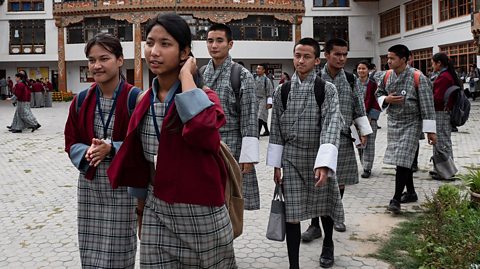School is one of the most important times in a personās life - but what it looks like can vary greatly depending on where you are in the world.
Every country has their own approach to education and each classroom is shaped by different values and philosophies. From uniforms to school dinners, “óĻó“«Ć½ Bitesize takes a look at some of the surprising ways that schools differ around the world.
What age do kids start going to school?
Compulsory school starting ages vary across the globe, but children typically begin between the ages of three to seven.
Primary pupils in France and Hungary are among the youngest to enter compulsory education, with the starting age set at three. Both countries also have one of the longest duration of full-time mandatory education in Europe, lasting 13 years.
Some children donāt start school until much later. In Finland, Estonia and Lithuania pupils arenāt required to start education until they reach the age of seven - but will often attend some form of pre-school before this.

What do school uniforms look like?
School uniforms have a long history. The first documented example of students wearing academic dress can be traced back to 13th-Century England, when the Archbishop of Canterbury mandated pupils to wear a robe-like outfit called the cappa clausa.
While a shirt, tie and blazer is a popular combination for those in Britain, Malta and Ireland, others wear traditional garments connected to their culture.
In Bhutan, students wear their national dress to school. The gho, worn by boys, is a knee-length robe tied at the waist, whereas the kira, worn by girls, is a long dress made from a rectangular piece of woven fabric. The gho and kira form part of the Driglam namzha, the official guideline for etiquette and dress code in Bhutan since it was introduced in the 17th Century.
For some, wearing a uniform is a badge of pride and creates an identity for a school. However, for some countries, such as the United States and Switzerland, school uniform generally isnāt a compulsory requirement.
When does the academic year start around the world?
The start of the academic year is structured differently depending on the country. In Scotland, the secondary school year is split into three terms over 190 days, typically beginning in August and ending in June.
Other countries split the academic year into two separate semesters. Students in South Korea generally have their first term from March until July, and the second which takes place from September through to February. They also have one of the longest school days in the world, with high school classes beginning at roughly 8.00am and finishing at around 4pm or 4.30pm.
Countries in the Southern Hemisphere tend to align the academic year with the calendar year. For example, in South Africa the school calendar runs over four terms from January until December.

What do school meals look like?
But it isnāt just uniforms and start dates that set schools from across the world apart - itās also the food put on a pupilās plate.
School lunches in France consist of four courses, generally made up of a vegetable starter, a warm main course, cheese and dessert. Lunches in Spain often feature a protein over brown rice and vegetables, bread and an orange.
India has one of the largest school lunch system in the world, where pupils are typically served foods such as khichdi, a dish made from rice and lentils.
In Japan, school meals, known as kyushoku, can comprise of rice, vegetables and soup - but it is the responsibility of students to serve school lunches for their peers. This is to help learn and promote healthy eating.
How are lessons taught?
There are also a wide range of teaching approaches across the globe. Finlandās education system is often ranked amongst the highest in the world. The country only has one compulsory examination, comprising of at least four tests, and if that wasnāt enough - homework isnāt widely used either. While there is a national curriculum, there arenāt any set texts or exams, meaning teachers have creative freedom in the classroom.
In South Asia, a mastery approach is used to teach maths, particularly in schools across China and Singapore. Part of this teaching means that all pupils perform the same work at the same time, allowing each class to master and advance to the next concept together as a group.
Other countries have been inspired by the high-performance results produced by the method. In 2016 the Department for Education announced that would introduce the maths mastery approach in primary schools across England.
This article was published in August 2023
How would animals do at school?
Discover six wildlife wonders that might top the class at certain subjects.

Back to school 2022: Four things to get you in the back to school mindset
With the sound of school bells just around the corner, check out these tips to get you ready for the back to school season.

The brilliantly brutal back to school quiz
Schoolās in for autumn ā nowās your chance to test your knowledge.
